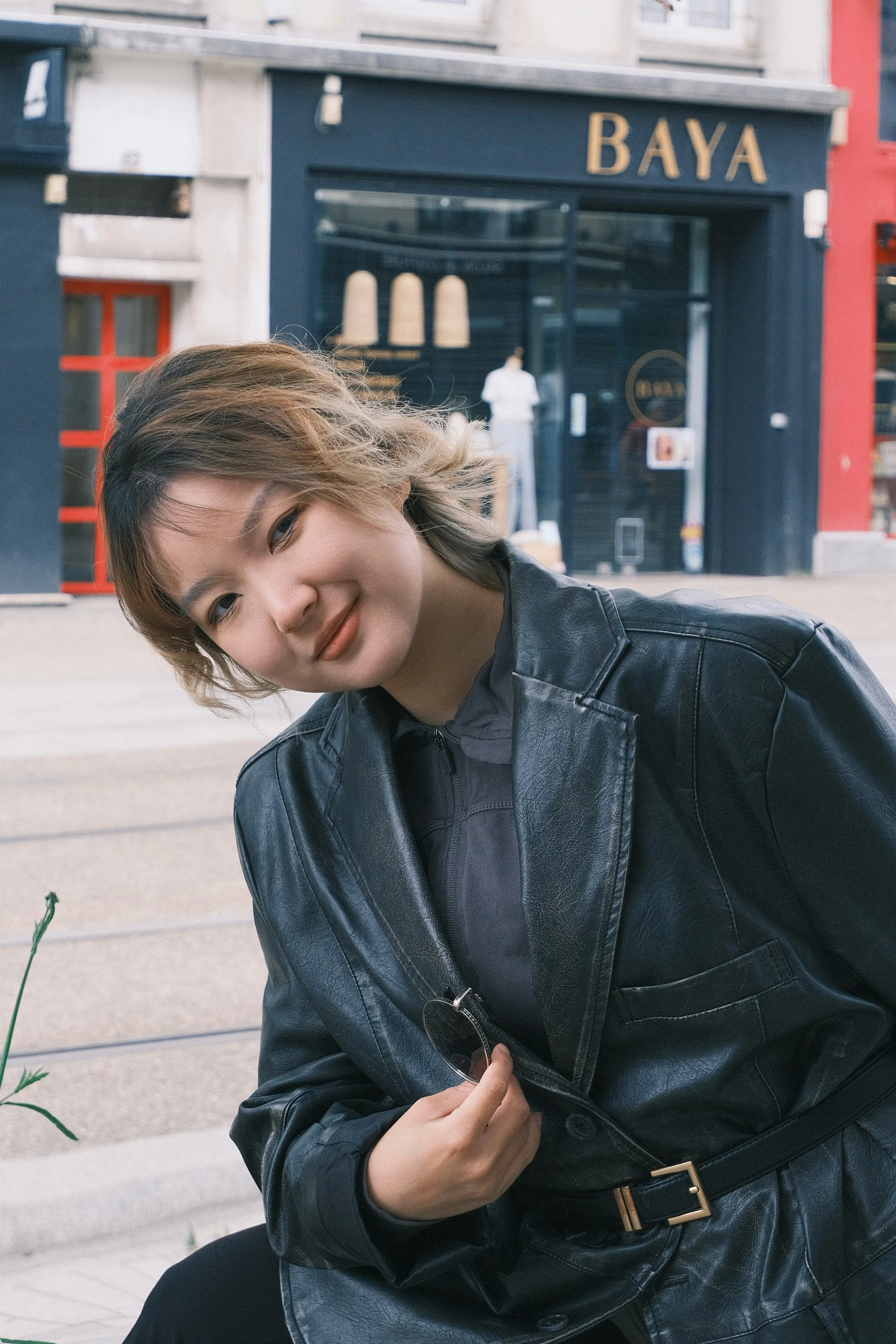10 Questions with Xingyu Dai
As a photographer, Xingyu Dai is deeply interested in the overlooked, the unspoken, and the subtle moments that often go unnoticed in everyday life. Her work aims to illuminate these hidden spaces where silence conveys more than words ever could. For her, art serves as a powerful means to make the invisible visible, the unheard audible, and the ignored acknowledged.
She often tends to use bold colour contrasts to create clean yet impactful images, a visual strategy that helps emphasise the tension between external pressures and personal experience. Through her photography, she captures the intangible pressures and silent judgments that shape personal identity, nuanced experiences often lost in a society preoccupied with constant evaluation. Her practice thoughtfully engages with these quiet struggles, exploring the complex space between societal expectations and inner realities, while consistently reflecting on social issues and the emotional landscape within.
Xingyu Dai - Portrait
Blade | Project Statement
In the series Blade, the artist explores the pressure and judgment that modern women face regarding their bodies. In a society obsessed with appearance, the experience of being scrutinised is likened to a blade, sharp, invasive, and relentless. The measuring tape, a symbol of this constant evaluation, represents how society “measures” women, reducing their bodies to objects to be examined and critiqued.
The red flowers bleeding into the monochrome are no mere embellishment. They symbolise wounds made visible, a silent violence crystallised into pigment. The flowers, soft against the ruler’s edge, embody a beauty that refuses to heal. In the studio, the artist observed the measuring tape digging into skin, leaving temporary marks, fleeting imprints of what society carves permanently into self-image.
Through these images, attention is drawn to the silent trauma women endure in a world that continuously measures and critiques them. The figures remain still, as if caught in moments of vulnerability, their bodies simultaneously subject to and resistant against the forces acting upon them. The stark contrast between the black-and-white tones and the vivid red highlights the tension between external judgment and internal strength, between visible and invisible struggles faced daily.
Blade offers a quiet yet powerful reflection on wounds that are not always seen but deeply shape how women navigate the world. The work poses a question: When will the blade be recognised not as a tool, but as a weapon?
Blade, Photography, 30×20 cm, 2025 © Xingyu Dai
INTERVIEW
Let’s start from the basics. What first inspired you to focus on photography, and what does this medium represent for you?
What first drew me to photography was its ambiguity. It offers a space between reality and fiction, between recording and imagining. Throughout the process of creating, I often reflect on what I truly want to express, and this has helped me understand myself on a deeper level. I’m fascinated by how a photograph can hold silence, tension, and subtle narratives without the need for clear explanations.
What training or experiences helped you develop into the artist you are today?
My journey began the moment I picked up my first camera and continued through years of self-exploration and working within the creative industries. I have years of experience in visual production, which has helped me develop a sensitivity to both narrative and composition. However, I would say what truly shaped my perspective is my personal curiosity about human emotions and those silent inner struggles people often carry. I’ve always believed in learning through trial and exploration, rather than through conventional education.
Blade, Photography, 30×20 cm, 2025 © Xingyu Dai
Tell us a bit about your creative process. How do you go from the first idea to the final outcome?
The Blade series started from a fleeting thought, not from a detailed plan. Over time, I noticed how often people, especially friends around me, seemed to unconsciously judge their own bodies, and this observation compelled me to create this project. I try to keep my approach open during the shooting process, allowing details to emerge rather than adhering too strictly to preconceived angles or ideas. For example, midway through the project, I noticed how the tape measure left imprints on the model’s skin after being wrapped too tightly, something we then decided to document further, which became a significant element in the work. Editing also helps me understand what I’ve truly captured; sometimes the images reveal things I hadn’t consciously realised I was expressing.
In your series Blade, why did you choose the measuring tape as a central symbol? And what do the red flowers represent for you in this project?
The measuring tape symbolises societal standards, constraints, and invisible forms of judgement, particularly those imposed upon women. It is a quiet yet persistent pressure many of us grow up internalising. The red flowers carry more emotional meaning for me. They suggest beauty and fragility but also evoke associations with blood and survival. Together, these elements reflect how something as soft as beauty can bear the weight of violence and expectation.
When you photograph moments of vulnerability, what do you hope viewers will notice or feel?
I don’t expect these images to provide answers. I hope they can inspire reflection. They gently ask the viewer: how do we see ourselves, and how are we seen? As objects of observation, they won’t necessarily appear beautiful to everyone. Within a broader social context, they might even cause discomfort, but I believe discomfort matters. It reminds us of things we often overlook. If even one person pauses and begins to consider these questions, then the work has already found its purpose.
Blade, Photography, 30×20 cm, 2025 © Xingyu Dai
Blade, Photography, 30×20 cm, 2025 © Xingyu Dai
Your work explores the silent pressure women face. Why do you think photography is a good medium to express such complicated themes?
Photography embraces ambiguity. It leaves space for people to interpret, without forcing answers. Those unspoken, invisible, uncertain aspects are often at the heart of female experience. A photograph’s stillness can hold silence and pressure in a way words sometimes cannot.
How do your own personal experiences shape the way you see and capture these themes?
Much of my work tries to articulate feelings I couldn’t find words for as I was growing up, the sense of being measured, restricted, or quietly expected to fulfil certain roles. My sensitivity to these themes doesn’t come from theory; it comes from living alongside them. Photography became a way for me to make these invisible pressures visible, not only for myself but also for others.
What message or question do you hope people carry with them after seeing Blade?
I hope they’ll question the standards we so often accept without thinking. Who set these rules? Why do we feel we must follow them? Aesthetic ideals have varied so dramatically across history. Which moment in time should we use to decide whether or not we are “enough”? I hope people reflect on how beauty and violence often exist together, sometimes in the subtlest of forms. Perhaps the real question is: how much of ourselves have we shaped just to please others?
Blade, Photography, 30×20 cm, 2025 © Xingyu Dai
Looking ahead, are there other subjects or social issues you’re excited to explore through your photography?
I would like to continue exploring the links between control, vulnerability, and gender. I am also curious about how domestic spaces and physical behaviours reflect deeper emotional landscapes. I trust these threads will naturally lead me forward.
And lastly, are there any upcoming projects, exhibitions, or publications you want to share with our readers?
I’m currently working on a new photography project. This series focuses on the quiet traces people leave behind, exploring how absence can hold presence, and how memory quietly lingers in objects and spaces. It’s a more introspective and poetic exploration of emotional weight, memory, and existence. I hope to share more of this work soon. I’m also very grateful that more exhibitions and publications featuring my work are on the way.
Artist’s Talk
Al-Tiba9 Interviews is a promotional platform for artists to articulate their vision and engage them with our diverse readership through a published art dialogue. The artists are interviewed by Mohamed Benhadj, the founder & curator of Al-Tiba9, to highlight their artistic careers and introduce them to the international contemporary art scene across our vast network of museums, galleries, art professionals, art dealers, collectors, and art lovers across the globe.




















